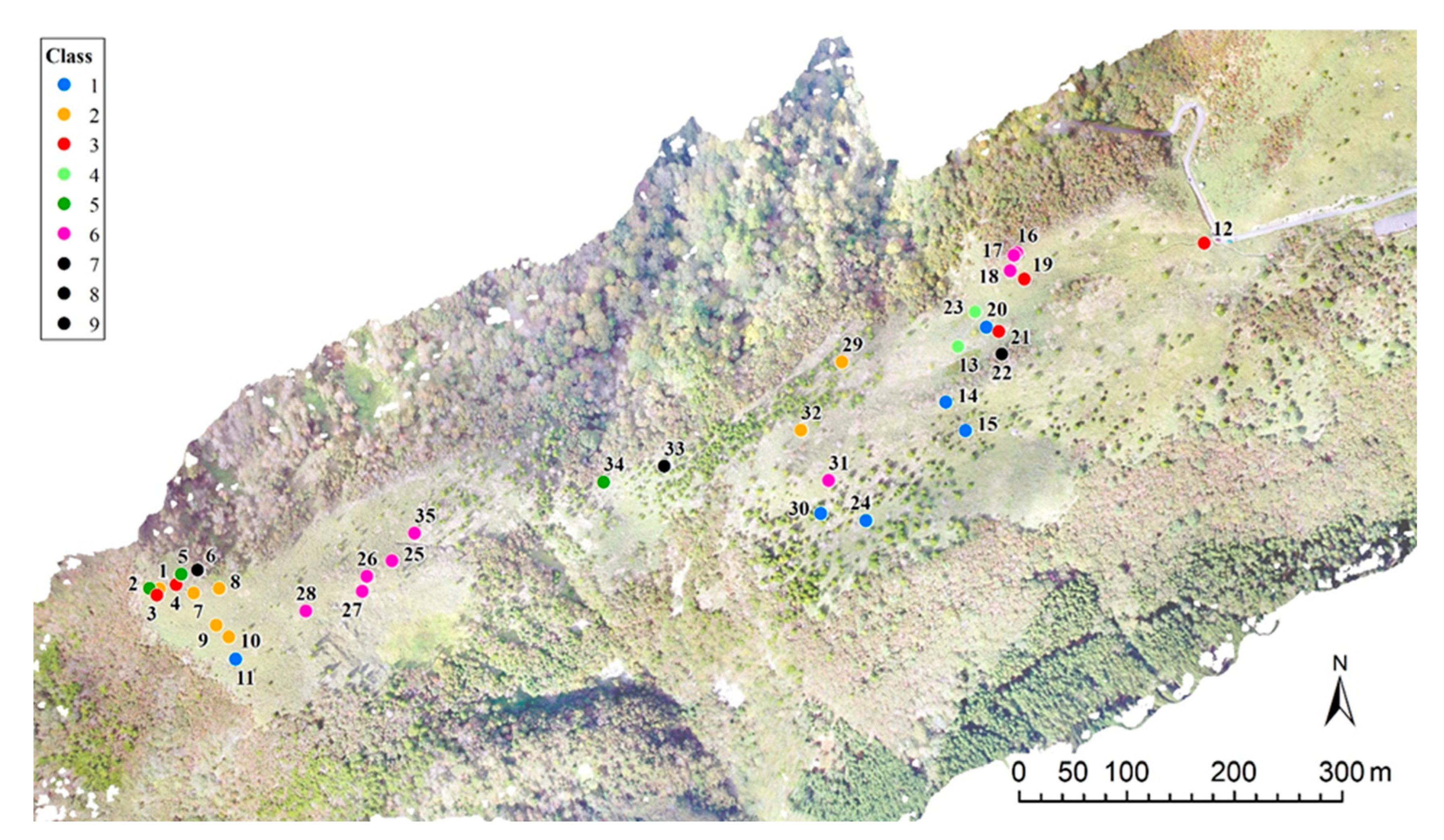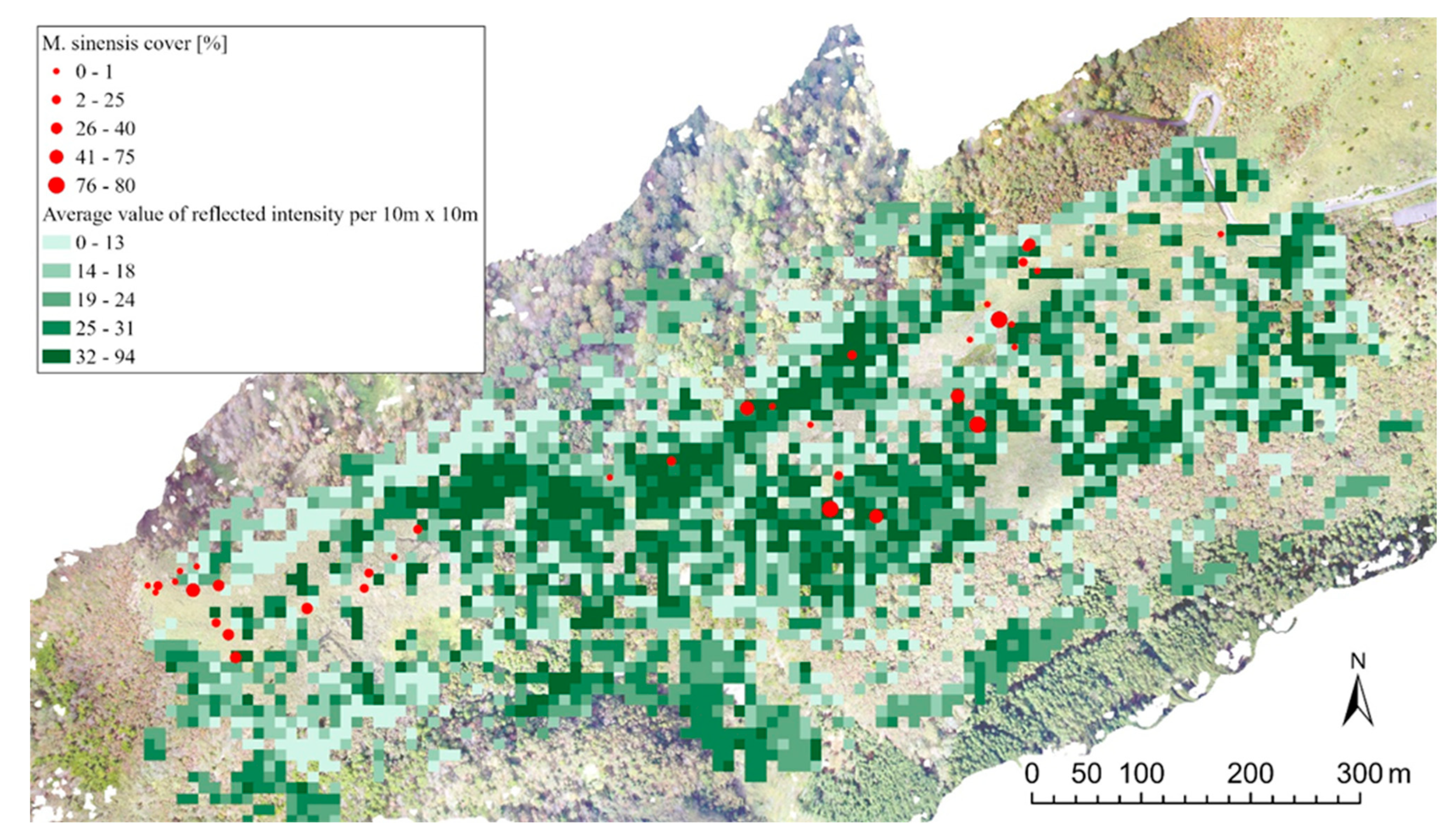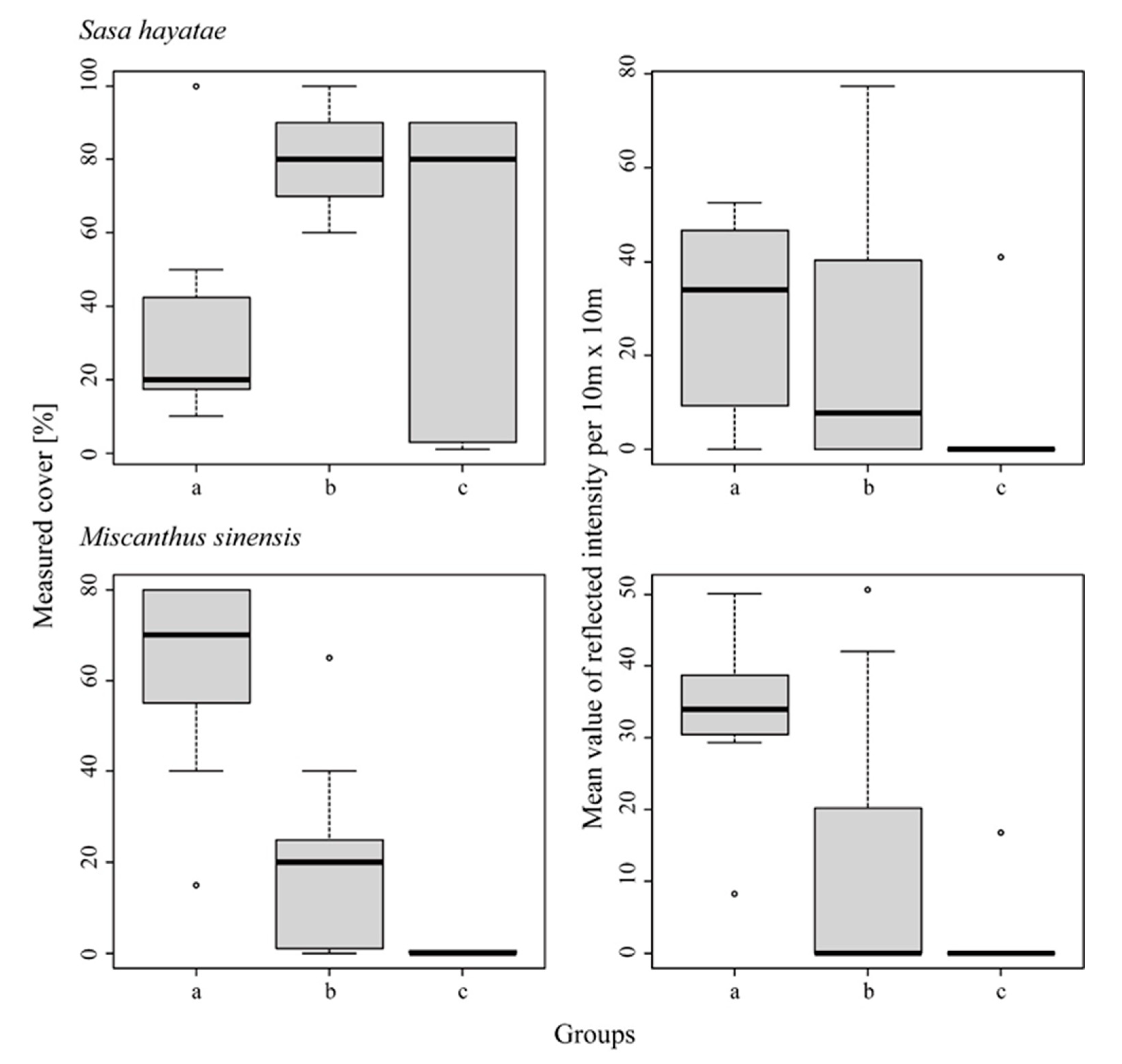Understanding 20 Years of Vegetation Change in Deer-Impacted Grasslands
Abstract
Highlights
- The deer browsing reduced the cover of S. hayatae and increased the cover of M. sinensis, but the extent of these changes was spatially heterogeneous.
- Using UAV-mounted LiDAR, we estimated the densities of S. hayatae and M. sinensis, which are important for understanding vegetation changes.
- In grassland management, understanding spatial and temporal changes in vegetation is important.
- The combination of small-scale field sampling and remote sensing is an excellent approach to obtain important information for grassland management.
Abstract
1. Introduction
2. Materials and Methods
2.1. Study Site
2.2. Vegetation Survey
2.3. Estimation of the Density of S. hayatae and M. sinensis
3. Results
3.1. Vegetation Survey
3.2. Estimation of the Density of S. hayatae and M. sinensis
3.3. Evaluation of Areas Important for Grassland Species Conservation
4. Discussion
4.1. Vegetation Change
4.2. Estimation of the Density of S. hayatae and M. sinensis
4.3. Grassland Management
5. Conclusions
Author Contributions
Funding
Data Availability Statement
Conflicts of Interest
References
- Gill, R.M.A. A Review of Damage by Mammals in North Temperate Forests: 1. Deer. For. Int. J. For. Res. 1992, 65, 145–169. [Google Scholar] [CrossRef]
- Takahashi, K.; Uehara, A.; Takatsuki, S. Food habits of Sika deer at Otome Highland, Yamanashi, with reference to Sasa nipponica. Mammal Study 2013, 38, 231–234. [Google Scholar] [CrossRef]
- Anderson, R.C.; Katz, A.J. Recovery of browse-sensitive tree species following release from white-tailed deer Odocoileus virginianus zimmerman browsing pressure. Biol. Conserv. 1993, 63, 203–208. [Google Scholar] [CrossRef]
- Horsley, S.B.; Stout, S.L.; DeCalesta, D.S. White-tailed deer impact on the vegetation dynamics of a northern hardwood forest. Ecol. Appl. 2003, 13, 98–118. [Google Scholar] [CrossRef]
- Rooney, T.P. High white-tailed deer densities benefit graminoids and contribute to biotic homogenization of forest ground-layer vegetation. Plant Ecol. 2009, 202, 103–111. [Google Scholar] [CrossRef]
- Inatomi, Y.; Uno, H.; Iijima, H. Effects of sika deer (Cervus nippon) and dwarf bamboo (Sasa senanensis) on trillium populations in Akan National Park, eastern Hokkaido, Japan. Plant Species Biol. 2017, 32, 423–431. [Google Scholar] [CrossRef]
- Otsu, C.; Iijima, H.; Nagaike, T. Plant community recovery from intense deer grazing depends on reduction of graminoids and the time after exclosure installation in a semi-natural grassland. PeerJ 2019, 7, e7833. [Google Scholar] [CrossRef] [PubMed]
- Rooney, T.P.; Waller, D.M. Direct and indirect effects of white-tailed deer in forest ecosystems. For. Ecol. Manag. 2003, 181, 165–176. [Google Scholar] [CrossRef]
- Rooney, T.; Dress, W. Species loss over sixty-six years in the ground-layer vegetation of heart’s content, and old-growth forest in Pennsylvania, USA. Nat. Areas J. 1997, 17, 297–305. [Google Scholar]
- Tanentzap, A.J.; Burrows, L.E.; Lee, W.G.; Nugent, G.; Maxwell, J.M.; Coomes, D.A. Landscape-level vegetation recovery from herbivory: Progress after four decades of invasive red deer control. J. Appl. Ecol. 2009, 46, 1064–1072. [Google Scholar] [CrossRef]
- Nuttle, T.; Ristau, T.E.; Royo, A.A. Long-term biological legacies of herbivore density in a landscape-scale experiment: Forest understoreys reflect past deer density treatments for at least 20 years. J. Ecol. 2014, 102, 221–228. [Google Scholar]
- Boulanger, V.; Baltzinger, C.; Said, S.; Ballon, P.; Picard, J.F.; Dupouey, J.L. Decreasing deer browsing pressure influenced understory vegetation dynamics over 30 years. Ann. For. Sci. 2015, 72, 367–378. [Google Scholar] [CrossRef]
- Yamamoto, Y.; Saito, Y.; Kirita, H.; Hayashi, H.; Nishimura, N. Ordination of vegetation of miscanthus-type grassland under the some artificial pressure. Jpn. J. Grassl. Sci. 1997, 42, 307–314. [Google Scholar]
- Takatsuki, S.; Ishikawa, S.; Higa, M. Altitudinal variation in sika deer food habits on Mt. Miune, Shikoku, Japan. Jpn. J. Ecol. 2021, 71, 5. [Google Scholar]
- Okubo, K. The present state in the study of biological diversity on semi-natural grassland in Japan. Jpn. J. Grassl. Sci. 2002, 48, 268–276. [Google Scholar]
- Weisberg, P.J.; Bonavia, F.; Bugmann, H. Modeling the interacting effects of browsing and shading on mountain forest tree regeneration (Picea abies). Ecol. Model. 2005, 185, 213–230. [Google Scholar] [CrossRef]
- Wisdom, M.J.; Vavra, M.; Boyd, J.M.; Hemstrom, M.A.; Ager, A.A.; Johnson, B.K. Understanding ungulate herbivory—Episodic disturbance effects on vegetation dynamics: Knowledge gaps and management needs. Wildl. Soc. Bull. 2006, 34, 283–292. [Google Scholar] [CrossRef]
- Yamamoto, Y. Succession and various vegetation of grassland. Jpn. J. Grassl. Sci. 2001, 47, 424–429. [Google Scholar]
- Baeza, S.; Lezama, F.; Piñeiro, G.; Altesor, A.; Paruelo, J.M. Spatial variability of above-ground net primary production in Uruguayan grasslands: A remote sensing approach. Appl. Veg. Sci. 2010, 13, 72–85. [Google Scholar]
- Zhang, X.; Bao, Y.; Wang, D.; Xin, X.; Ding, L.; Xu, D.; Hou, L.; Shen, J. Using UAV lidar to extract vegetation parameters of inner mongolian grassland. Remote Sens. 2021, 13, 656. [Google Scholar]
- Maake, R.; Mutanga, O.; Chirima, G.; Sibanda, M. Quantifying Aboveground Grass Biomass Using Space-Borne Sensors: A Meta-Analysis and Systematic Review. Geomatics 2023, 3, 478–500. [Google Scholar] [CrossRef]
- Fisher, R.J.; Sawa, B.; Prieto, B. A novel technique using LiDAR to identify native-dominated and tame-dominated grasslands in Canada. Remote Sens. Environ. 2018, 218, 201–206. [Google Scholar] [CrossRef]
- da Rocha, N.S.; Veettil, B.K.; Ward, R.D.; Costi, J.; Rolim, S.B.A. Remote sensing of grasslands in the South American Pampas (scientometrics analysis). Land Degrad. Dev. 2023, 34, 2723–2734. [Google Scholar] [CrossRef]
- Kogushi, S.; Kamada, M.; Hasegawa, K. Vegetation change relating to a change of management ad Ochiai-Pass in Higashi-Iyayama Village in Tokushima Prefecture, Shikoku, Japan, Bull. Tokushima Pref. Mus. 2005, 15, 1–20. [Google Scholar]
- Kamada, M. Process of the establishment and maintenance of Sasa grassland in Tsurugi Mountains in Tokushima Prefecture, Shikoku, Japan, Bull. Tokushima Pref. Mus. 1994, 4, 97–113. [Google Scholar]
- Niwa, H.; Dai, G.; Ogawa, M.; Kamada, M. Development of a Monitoring Method Using UAVs That Can Detect the Occurrence of Bark Stripping by Deer. Remote Sens. 2023, 15, 644. [Google Scholar] [CrossRef]
- Hashimoto, Y.; Fujiki, D. List of food plants and unpalatable plants of sika deer (Cervus nippon) in Japan. Hum. Nat. 2014, 25, 133–160. [Google Scholar]
- Sakanoue, S. Long-term trends in Miscanthus sinensis grassland vegetation: A 20-year field observation. Jpn. J. Grassl. Sci. 2001, 47, 430–435. [Google Scholar]
- Yamamoto, Y.; Saito, Y.; Kirita, H.; Takahashi, S.; Kitahara, N. Difference in vegetational changes in miscanthus-type grassland following cutting and burning treatments. Jpn. J. Grassl. Sci. 2007, 53, 28–30. [Google Scholar]
- Hashimoto, Y.; Ishimaru, K.; Kuroda, A.; Masunaga, S.; Yokota, J. Effects of mowing resumption on recovery and richness of grassland plant species in abandoned grasslands dominated by dwarf bamboo. Landsc. Res. Jpn. Online 2012, 5, 95. [Google Scholar] [CrossRef]
- Nakashizuka, T. Regeneration of beech (Fagus crenata) after the simultaneous death of undergrowing dwarf bamboo (Sasa kurilensis). Ecol. Res. 1988, 3, 21–35. [Google Scholar] [CrossRef]
- Yokoyama, M.; Kaji, K.; Suzuki, M. Food habits of sika deer and nutritional value of sika deer diets in eastern Hokkaido, Japan. Ecol. Res. 2000, 15, 345–355. [Google Scholar] [CrossRef]
- Takatsuki, S.; Uehara, A. Cause of vegetation changes to a Miscanthus sinensis community in Otome Highland, Yamanashi, central Japan. Veg. Sci. 2021, 38, 81–93. [Google Scholar]
- Tanaka, Y.; Takatsuki, S.; Takayanagi, A. Decline of Sasa palmata community by grazing of Sika deer (Cervus nippon) at Ashiu Research Forest Station. For. Res. Kyoto 2008, 77, 13–23. [Google Scholar]
- Sakanoue, S.; Fukuda, E.; Ogawa, Y.; Okamoto, K.; Kitahara, N. Successional process in a Sasa nipponica grassland through summer grazing by beef cattle. Jpn. J. Grassl. Sci. 1995, 40, 443–447. [Google Scholar]
- Milchunas, D.G.; Noy-Meir, I. Grazing refuges, external avoidance of herbivory and plant diversity. Oikos 2002, 99, 113–130. [Google Scholar] [CrossRef]
- Callaway, R.M.; Kikodze, D.; Chiboshvili, M.; Khetsuriani, L. Unpalatable plants protect neighbors from grazing and increase plant community diversity. Ecology 2005, 86, 1856–1862. [Google Scholar] [CrossRef]
- Aragón, R.; Oesterheld, M. Linking vegetation heterogeneity and functional attributes of temperate grasslands through remote sensing. Appl. Veg. Sci. 2008, 11, 117–130. [Google Scholar] [CrossRef]










| Family | Scientific Name | Red List | Unpalatable Species | |
|---|---|---|---|---|
| Tokushima Pref. | Ministry of the Environment | |||
| Amaryllidaceae | Allium thunbergii | |||
| Anacardiaceae | Toxicodendron orientale subsp. orientale | |||
| Araliaceae | Kalopanax septemlobus | |||
| Asteraceae | Cirsium japonicum var. horridum | ● | ||
| Asteraceae | Crassocephalum crepidioides | ● | ||
| Asteraceae | Erechtites hieraciifolius | ● | ||
| Asteraceae | Ixeridium dentatum | |||
| Asteraceae | Solidago virgaurea subsp. leiocarpa | |||
| Blechnaceae | Struthiopteris niponica | |||
| Campanulaceae | Adenophora triphylla subsp. aperticampanulata | |||
| Caryophyllaceae | Stellaria sessiliflora | |||
| Clethraceae | Clethra barbinervis | |||
| Dennstaedtiaceae | Hypolepis punctata | ● | ||
| Elaeagnaceae | Elaeagnus umbellata var. umbellata | |||
| Ericaceae | Lyonia ovalifolia var. elliptica | ● | ||
| Ericaceae | Rhododendron kaempferi var. kaempferi | |||
| Ericaceae | Rhododendron tsurugisanense | NT | ||
| Ericaceae | Vaccinium oldhamii | |||
| Ericaceae | Vaccinium smallii var. versicolor | |||
| Fagaceae | Quercus crispula var. crispula | |||
| Gentianaceae | Gentiana scabra var. buergeri | |||
| Gentianaceae | Tripterospermum japonicum | ● | ||
| Geraniaceae | Geranium shikokianum var. shikokianum | NT | NT | |
| Haloragaceae | Gonocarpus micranthus | |||
| Hydrangeaceae | Hydrangea hydrangeoides | ● | ||
| Hydrangeaceae | Hydrangea paniculata | |||
| Hypericaceae | Hypericum erectum | |||
| Hypericaceae | Hypericum sikokumontanum | |||
| Juncaceae | Juncus decipiens | ● | ||
| Lamiaceae | Comanthospace japonica | ● | ||
| Lamiaceae | Glechoma hederacea subsp. grandis | |||
| Lardizabalaceae | Akebia trifoliata | |||
| Liliaceae | Tricyrtis macropoda | EN | ||
| Lycopodiaceae | Lycopodium dendroideum | ● | ||
| Oleaceae | Fraxinus sieboldiana | |||
| Onagraceae | Circaea alpina subsp. alpina | |||
| Osmundaceae | Osmunda japonica | ● | ||
| Oxalidaceae | Oxalis nipponica subsp. nipponica | CR | ||
| Pinaceae | Abies homolepis | |||
| Poaceae | Arundinella hirta | |||
| Poaceae | Carex sp. | |||
| Poaceae | Miscanthus sinensis | ● | ||
| Poaceae | Poaceae sp. | |||
| Poaceae | Sasa hayatae | |||
| Polygalaceae | Polygala japonica | |||
| Polygonaceae | Fallopia japonica | |||
| Primulaceae | Lysimachia japonica | |||
| Rosaceae | Potentilla hebiichigo | |||
| Rosaceae | Rosa multiflora | ● | ||
| Rosaceae | Rubus crataegifolius | |||
| Rosaceae | Rubus illecebrosus | |||
| Rosaceae | Rubus palmatus var. coptophyllus | |||
| Rosaceae | Sorbus commixta | |||
| Rubiaceae | Galium trifidum subsp. columbianum | |||
| Salicaceae | Salix sieboldiana var. sieboldiana | |||
| Sapindaceae | Acer micranthum | |||
| Sapindaceae | Acer rufinerve | ● | ||
| Sapindaceae | Acer sieboldianum | |||
| Symplocaceae | Symplocos coreana | |||
| Thelypteridaceae | Thelypteris pozoi subsp. mollissima | ● | ||
| Urticaceae | Pilea pumila | |||
| Viburnaceae | Viburnum furcatum | |||
| Violaceae | Viola sp. | |||
| Factors | Code | R2 | Pr(>r) |
|---|---|---|---|
| S. hayatae cover 2002 | SC2002 | 0.06 | 0.35 |
| S. hayatae cover 2022 | SC2022 | 0.08 | 0.26 |
| M. sinensis cover 2002 | MC2002 | 0.10 | 0.19 |
| M. sinensis cover 2022 | MC2022 | 0.57 | 0.00 |
| Change in S. hayatae cover | CiSC | 0.17 | 0.05 |
| Change in M. sinensis cover | CiMC | 0.21 | 0.02 |
| Height [m] | Sasa hayatae | Miscanthus sinensis | ||||||
|---|---|---|---|---|---|---|---|---|
| Number | Intensity | Number | Intensity | |||||
| R2 | p | R2 | p | R2 | p | R2 | p | |
| 0–0.1 | 0.01 | 0.137 | 0.01 | 0.135 | <0.01 | 0.387 | <0.01 | 0.520 |
| 0.1–0.2 | <0.01 | 0.281 | <0.01 | 0.165 | <0.01 | 0.505 | <0.01 | 0.609 |
| 0.2–0.3 | <0.01 | 0.713 | <0.01 | 0.176 | <0.01 | 0.888 | <0.01 | 0.684 |
| 0.3–0.4 | <0.01 | 0.644 | <0.01 | 0.196 | <0.01 | 0.512 | <0.01 | 0.684 |
| 0.4–0.5 | <0.01 | 0.544 | <0.01 | 0.185 | <0.01 | 0.228 | <0.01 | 0.684 |
| 0.5–0.6 | <0.01 | 0.336 | <0.01 | 0.279 | <0.01 | 0.223 | <0.01 | 0.637 |
| 0.6–0.7 | <0.01 | 0.271 | <0.01 | 0.183 | <0.01 | 0.585 | <0.01 | 0.713 |
| 0.7–0.8 | <0.01 | 0.652 | 0.02 | 0.086 | <0.01 | 0.727 | <0.01 | 0.719 |
| 0.8–0.9 | <0.01 | 0.838 | <0.01 | 0.252 | <0.01 | 0.357 | <0.01 | 0.891 |
| 0.9–1 | <0.01 | 0.971 | <0.01 | 0.254 | <0.01 | 0.477 | <0.01 | 0.757 |
| 1–1.1 | <0.01 | 0.968 | <0.01 | 0.210 | <0.01 | 0.441 | <0.01 | 0.698 |
| 1.1–1.2 | <0.01 | 0.892 | <0.01 | 0.270 | <0.01 | 0.422 | <0.01 | 0.780 |
| 1.2–1.3 | <0.01 | 0.461 | <0.01 | 0.397 | 0.01 | 0.127 | <0.01 | 0.946 |
| 1.3–1.4 | <0.01 | 0.243 | <0.01 | 0.303 | <0.01 | 0.715 | 0.02 | 0.090 |
| 1.4–1.5 | <0.01 | 0.735 | <0.01 | 0.237 | <0.01 | 0.283 | 0.04 | 0.020 |
| 1.5–1.6 | <0.01 | 0.645 | <0.01 | 0.310 | <0.01 | 0.303 | 0.03 | 0.038 |
| 1.6–1.7 | <0.01 | 0.744 | <0.01 | 0.316 | <0.01 | 0.259 | 0.04 | 0.023 |
| 1.7–1.8 | <0.01 | 0.676 | <0.01 | 0.394 | <0.01 | 0.321 | 0.04 | 0.026 |
| 1.8–1.9 | <0.01 | 0.863 | <0.01 | 0.592 | <0.01 | 0.168 | 0.03 | 0.039 |
| 1.9–2 | <0.01 | 0.743 | <0.01 | 0.407 | <0.01 | 0.336 | <0.01 | 0.796 |
| Classes of NMDS | Three Categories Based on Their Positions Relative to the M. sinensis Cover 2022 | Estimation of the Density of M. sinensis (The Mean Values of the Reflected Intensity at a Height of 1.4–1.5 m) | Grassland Plant Diversity |
|---|---|---|---|
| 1 | a | 30–40 | High |
| 7 | |||
| 2 | b | 0–20 | Low |
| 3 | |||
| 6 | |||
| 4 | c | 0 | Low |
| 5 | |||
| 8 | na | ||
| 9 |
Disclaimer/Publisher’s Note: The statements, opinions and data contained in all publications are solely those of the individual author(s) and contributor(s) and not of MDPI and/or the editor(s). MDPI and/or the editor(s) disclaim responsibility for any injury to people or property resulting from any ideas, methods, instructions or products referred to in the content. |
© 2025 by the authors. Licensee MDPI, Basel, Switzerland. This article is an open access article distributed under the terms and conditions of the Creative Commons Attribution (CC BY) license (https://creativecommons.org/licenses/by/4.0/).
Share and Cite
Niwa, H.; Dai, G.; Ogawa, M.; Kamada, M. Understanding 20 Years of Vegetation Change in Deer-Impacted Grasslands. Remote Sens. 2025, 17, 3187. https://doi.org/10.3390/rs17183187
Niwa H, Dai G, Ogawa M, Kamada M. Understanding 20 Years of Vegetation Change in Deer-Impacted Grasslands. Remote Sensing. 2025; 17(18):3187. https://doi.org/10.3390/rs17183187
Chicago/Turabian StyleNiwa, Hideyuki, Guihang Dai, Midori Ogawa, and Mahito Kamada. 2025. "Understanding 20 Years of Vegetation Change in Deer-Impacted Grasslands" Remote Sensing 17, no. 18: 3187. https://doi.org/10.3390/rs17183187
APA StyleNiwa, H., Dai, G., Ogawa, M., & Kamada, M. (2025). Understanding 20 Years of Vegetation Change in Deer-Impacted Grasslands. Remote Sensing, 17(18), 3187. https://doi.org/10.3390/rs17183187





